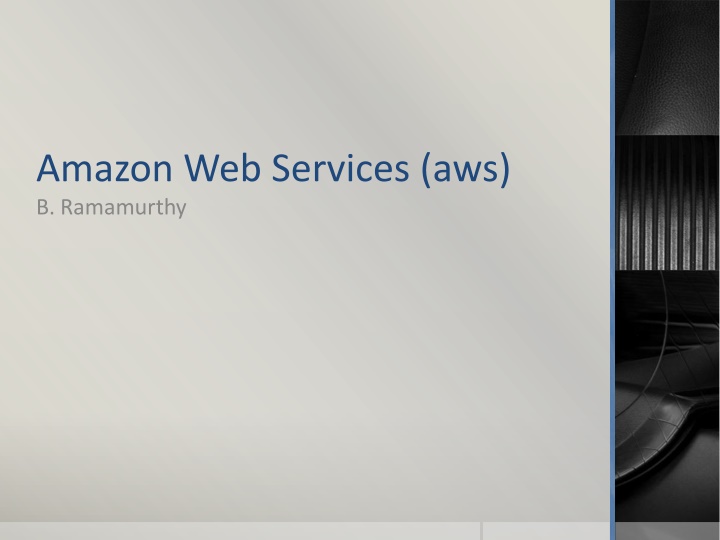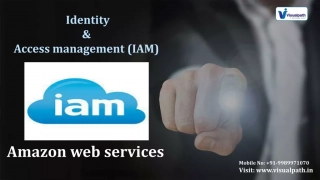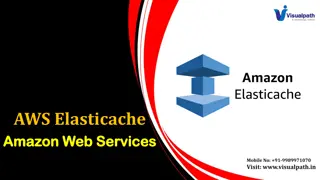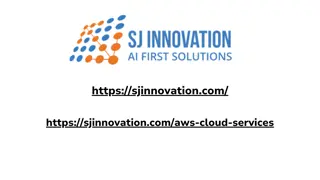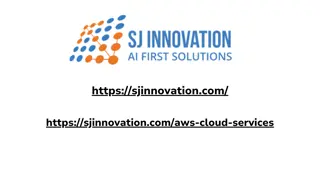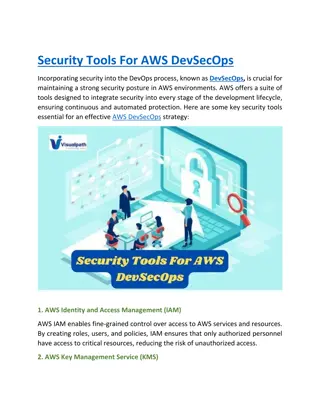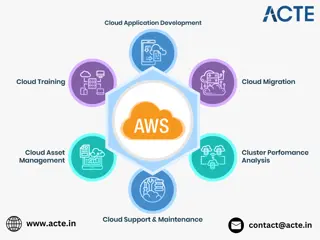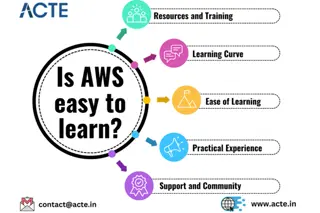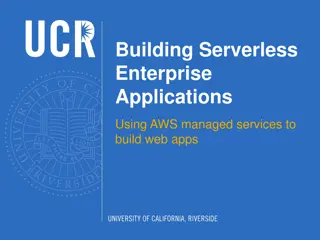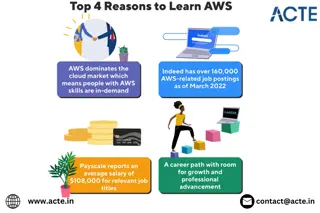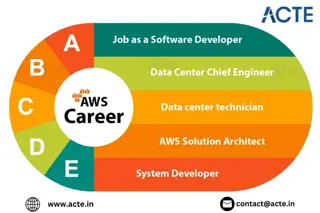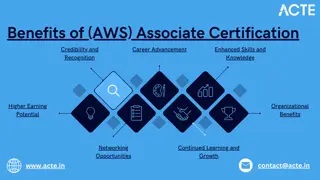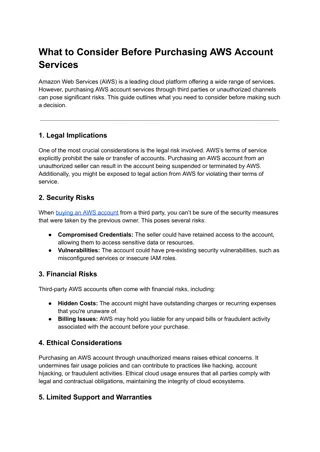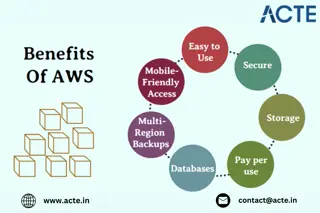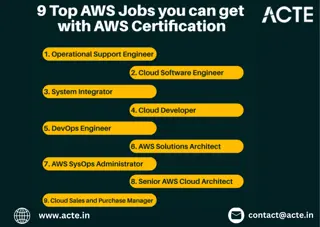Introduction to Amazon Web Services (AWS) by B. Ramamurthy
Amazon Web Services (AWS) by B. Ramamurthy provides insights into leveraging cloud services offered by Amazon for building and running applications. The guide includes steps to get started with AWS, exploring service layers, and understanding the capabilities of AWS such as file storage using Amazon S3. With hands-on tutorials and references, users can learn to utilize AWS for various purposes from websites and applications to media storage and private networks.
Download Presentation

Please find below an Image/Link to download the presentation.
The content on the website is provided AS IS for your information and personal use only. It may not be sold, licensed, or shared on other websites without obtaining consent from the author.If you encounter any issues during the download, it is possible that the publisher has removed the file from their server.
You are allowed to download the files provided on this website for personal or commercial use, subject to the condition that they are used lawfully. All files are the property of their respective owners.
The content on the website is provided AS IS for your information and personal use only. It may not be sold, licensed, or shared on other websites without obtaining consent from the author.
E N D
Presentation Transcript
Amazon Web Services (aws) B. Ramamurthy
Introduction Amazon.com, the online market place for goods, has leveraged the services that worked for their own business and has made them available as cloud services, amazon web services (aws) aws.amazon.com Get an account on aws.amazon.com/free the free tier for services Next step is to study the documentation available on various services : https://aws.amazon.com/documentation/ Follow the documentation with hands-on tutorials. CSE651, B. Ramamurthy 7/11/2014 2
References aws.amazon.com http://docs.aws.amazon.com/gettingstarted/latest/aw sgsg-intro/gsg-aws-intro.html http://docs.aws.amazon.com/AmazonS3/latest/gsg/G etStartedWithS3.html CSE651, B. Ramamurthy 7/11/2014 3
CSE651, B. Ramamurthy 7/11/2014 4
Getting Started with AWS Amazon Web Services (AWS) provides computing resources and services that you can use to build applications within minutes at pay-as-you-go pricing. For example, you can rent a server on AWS that you can connect to, configure, secure, and run just as you would a physical server. The difference is the virtual server runs on top of a planet- scale network managed by AWS. Using AWS to build your Internet application is like purchasing electricity from a power company instead of running your own generator CSE651, B. Ramamurthy 7/11/2014 5
Service layers CSE651, B. Ramamurthy 7/11/2014 6
What can you do with aws? You can run nearly anything on AWS that you would run on physical hardware: websites, applications, databases, mobile apps, email campaigns, distributed data analysis, media storage, and private networks. CSE651, B. Ramamurthy 7/11/2014 7
Store file: lets try it out Amazon Web Service Free usage tier? What it does Yes 5 GB storage 20,000 Get requests 2,000 Put requests Stores and retrieves digital files. Amazon Simple Storage Service (Amazon S3) CSE651, B. Ramamurthy 7/11/2014 8
Simple Storage Service (S3) Amazon Simple Storage Service (Amazon S3) is storage for the internet. You can use Amazon S3 to store and retrieve any amount of data at any time, from anywhere on the web. The bucket name you choose must be unique across all existing bucket names in Amazon S3. One way to help ensure uniqueness is to prefix your bucket names with the name of your organization. Steps involved in using S3: 1. Sign up for s3 service 2. Create a bucket 3. Add an object to bucket 4. View an object 5. Move an object 6. Access an object from programs/consoles/web using: https://s3.amazonaws.com/Bucket/Object 7. Delete an object and a bucket CSE651, B. Ramamurthy 7/11/2014 9
Privacy and sharing an object All objects by default are private. Only the object owner has permission to access these objects. However, the object owner can optionally share objects with others by creating a pre-signed URL, using their own security credentials, to grant time-limited permission to download the objects. When you create a pre-signed URL for your object, you must provide your security credentials, specify a bucket name, an object key, specify the HTTP method (GET to download the object) and expiration date and time. The pre-signed URLs are valid only for the specified duration. Anyone who receives the pre-signed URL can then access the object. For example, if you have a video in your bucket and both the bucket and the object are private, you can share the video with others by generating a pre- signed URL. CSE651, B. Ramamurthy 7/11/2014 10
S3 Demo We will demo using S3Fox utility We will also demo using Amazon console CSE651, B. Ramamurthy 7/11/2014 11
Amazon Console CSE651, B. Ramamurthy 7/11/2014 12
Hosting a Web Site Static web site is a web site that does not require server site support: eg. html, js, css A static website does not require server-side processing and relies only on client-side technologies such as HTML, CSS, and JavaScript. CSE651, B. Ramamurthy 7/11/2014 13
AWS Services for web site hosting Amazon Web Service Free usage tier? What it does Yes 5 GB storage 20,000 Get requests 2,000 Put requests Stores files and can be configured to deliver them to browsers using an Internet URL. Amazon Simple Storage Service (Amazon S3) Attaches a custom domain name (e.g., http://example.com) to AWS resources. No Amazon Route 53 Yes 50 GB data transfer 2,000,000 requests per month Speeds up access to the website by caching the files in edge locations around the world. Amazon CloudFront CSE651, B. Ramamurthy 7/11/2014 14
Static website hosting architecture CSE651, B. Ramamurthy 7/11/2014 15
Web-site with custom domain (costs money) CSE651, B. Ramamurthy 7/11/2014 16
Web-site with performance mgt. (costs money) CSE651, B. Ramamurthy 7/11/2014 17
Step1: Choose a domain name When you host a website on Amazon S3, AWS assigns your website a URL based on the name of the storage location you create in Amazon S3 to hold the website files (called an S3 bucket) and the geographical region where you created the bucket. For example, if you create a bucket called cse651blr on the east coast of the United States and use it to host your website, the default URL will be http://cse651c.s3- website-us-east-1.amazonaws.com/. We will not use Route 53 and CloudFront for this proof-of- concept implementation. CSE651, B. Ramamurthy 7/11/2014 18
Next steps Open the Amazon S3 console at https://console.aws.amazon.com/s3/. Create 3 buckets in s3: cse651cjb.com, www.cse651cjb.com, logs.cse651cjb.com Upload the files of your static web page into cse651cjb.com bucket Set the permissions of cse651cjb.com to allow others to view: In the policy edit window enter the code given below and save. CSE651, B. Ramamurthy 7/11/2014 19
Permissions: policy code { "Version":"2008-10-17", "Statement":[{ "Sid":"Allow Public Access to All Objects", "Effect":"Allow", "Principal": { "AWS": "*" }, "Action":["s3:GetObject"], "Resource":["arn:aws:s3:::example.com/*" ] } ] } CSE651, B. Ramamurthy 7/11/2014 20
Enable logging and redirection In the logging window enter logs.cse651cjb.com and /root in the next box Right click on www.cse651cjb.com and redirect it to cse651blr.com Now upload all the files of static application into the bucket cse651cjb.com Click on the endpoint address that shows up in properties window of cse651cjb.com You should be able to see the static application. Enjoy. CSE651, B. Ramamurthy 7/11/2014 21
High-level architecture CSE651, B. Ramamurthy 7/11/2014 22
Pricing: Estimated Monthly Bill for this site If it is active with 30000 requests/client accesses is about $5.22/month http://docs.aws.amazon.com/gettingstarted/latest/sw h/static-website-hosting-pricing-s3.html CSE651, B. Ramamurthy 7/11/2014 23
Run a virtual server on AWS: Linux server
Amazon Elastic Compute Cloud (EC2) We completed an application using S3. For this exercise we will use the EC2 that is preeminent product of aws One can use EC2 to run and manage virtual servers on AWS. Your servers are launched as EC2 instances and initialized with a machine image called an AMI. In the free usage tier, you can launch a t1.micro Amazon EC2 instance. Micro instances provide a small amount of consistent CPU resources and allow you to burst CPU capacity when additional cycles are available. A t1.micro instance is well suited for low-throughput applications and websites that consume significant compute cycles only occasionally. For this exercise we will launch a Linux server using a Amazon Machine Image that is eligible for the free tier. CSE651, B. Ramamurthy 7/11/2014 25
Amazon Machine Images (AMI) CSE651, B. Ramamurthy 7/11/2014 26
Connect to the server After you launch the instance you need putty to ssh into your server. Note the dns for the launched server at the bottom half of the console: ec2-54-198-95-68.compute-1.amazonaws.com Convert the cse651b.pem into .ppk private key Launch a putty window and use all these items above and username ec2-user to log into the launched server. Work on some Linux commands to check this new launch out. (sudo yum install emacs) Make sure you terminate the server when you are done using it. This can be done from the EC2 dashboard CSE651, B. Ramamurthy 7/11/2014 27
Putty connect to Linux Server CSE651, B. Ramamurthy 7/11/2014 28
Run a virtual server on AWS: Windows server
Steps to acquire a Windows Server on aws Similar to Linux instance: Choose a free tier Windows 64 bit instance Use the same security keys-pair Set the security group to allow RDP, SSH Connect using RDP You can see the local system if you enable appropriate privileges when connecting Transfer software and install and use the server. Lets go on to the demo. Make sure you stop, and terminate the instance after done. CSE651, B. Ramamurthy 7/11/2014 30
Summary We looked at the capabilities of Amazon Web Services through 4 different examples; Working with S3 Static web app Launching an instance of Linux instance + working with it Launching an instance of Windows instance + working with it You can try all these if you can get an account on aws. CSE651, B. Ramamurthy 7/11/2014 31
